
Introduction
Bloc and GetX are both popular state management solutions for Flutter applications. However, they use different approaches to handle state management.
Bloc is a reactive state management solution that uses reactive programming and streams to handle state changes. Bloc provides a structured approach to state management, which makes it suitable for larger applications with multiple widgets interacting with each other.
On the other hand, GetX is a lightweight state management solution that uses getx bindings, dependency injection and observes the pattern to handle state changes. GetX provides a simple approach to state management, which makes it suitable for smaller applications with fewer interactions between widgets.
Architecture and Concepts
Bloc stands for Business Logic Component, an architectural pattern for implementing state management in Flutter apps. It emphasizes separating the business logic from the UI, allowing for cleaner, more modular code. With Bloc, a widget interacts with a bloc instance to invoke state changes, and the bloc updates the UI accordingly.
GetX, on the other hand, is not an architectural pattern but rather a set of libraries and tools that provide various features, including state management. GetX relies heavily on the Provider package, which makes it easier to handle data changes across the widget tree. GetX also offers other features such as dependency injection and routing.
Code Complexity
When it comes to code complexity, Bloc can be more verbose and thus harder to read and understand at first. It usually requires creating several classes for each feature used in the app, leading to a larger codebase. However, this architectural pattern can help build scalable and maintainable applications.
GetX, on the other hand, has a shorter learning curve and requires less boilerplate. It also simplifies the code by using reactive programming, which streamlines the data flow and makes it easier to handle state changes.
Performance
Both Bloc and GetX offer good performance in terms of managing state changes in Flutter apps. However, Bloc may be slightly more performant due to its strict unidirectional data flow, which avoids unnecessary widget rebuilds.
GetX’s reactive programming approach can also offer good performance, but it may introduce additional overhead in some cases, leading to slower app performance.
Documentation and Community Support
Bloc has a more established community and well-documented API, making it easier to find answers to questions and troubleshoot issues. There are also many tutorials and examples available online for developers to learn from.
GetX has a growing community and good documentation, but it may be harder to find support and resources compared to Bloc, especially for more complex use cases.
Integration with other libraries
Both Bloc and GetX integrate well with other libraries in the Flutter ecosystem, such as Firebase, GraphQL, and more. However, GetX offers more out-of-the-box features, including a built-in dependency injection system and router.
Summary
The choice between Bloc and GetX depends on the needs of the application. While Bloc is better suited for larger and more complex applications, GetX is ideal for smaller and simpler ones. However, both Bloc and GetX are excellent state management solutions that can help developers build high-quality Flutter applications.
Well, that’s If you need to hire mobile developer contact now. Thank you for reading, give it a clap or buy me a coffee!
Feel free to get in touch with us.